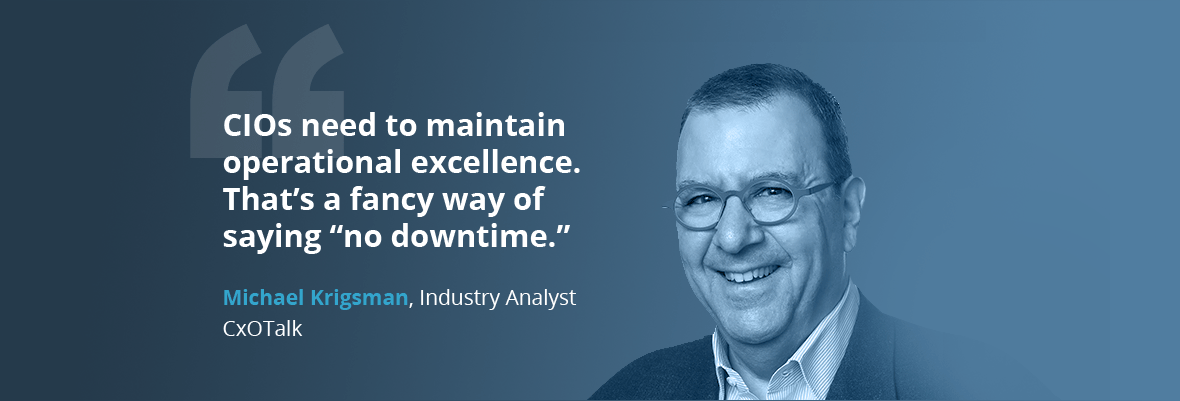Today on the blog, we feature a conversation with Michael Krigsman, an industry analyst and host of CxOTalk. He has been named a top CIO and IT influencer by several industry organizations. Michael writes extensively on the evolution of customer experience, and why technology is more critical to the delivery of competitive, compelling digital experiences than ever before.
OpsRamp: Customer experience has always been important in business but now in digital, it’s the elusive magic bullet to success. How has this challenge evolved?
MK: Customer experience is a significant driver of revenue over time. We now have the tools to track and personalize customer interactions, which has raised the profile of this important topic.
Twenty years ago, Facebook didn’t exist and Amazon was still brand new, so, by and large, we shopped in stores. At that time, we had less ability to connect customer interactions with outcomes like a purchase. Today, companies can establish a clearer linkage between a customer’s interactions with the brand and purchases they make; however, brands have less control over the message because customers interact with each other and do online searches before they buy. Human nature hasn’t changed but the technology has and organizations must evolve with it.
OpsRamp: Where should business and IT leaders focus their time and efforts on improving customer experience in 2020?
MK: Look systematically across the customer lifecycle, at all the interactions customers have with your brand. At each point, evaluate if those interactions are simple and positive. Ask whether you have the IT systems in place to gather the data created by those interactions.
Are you personalizing communications in a way that customers find appealing? A significant portion of Amazon sales come from recommendations they serve to customers. When somebody buys based on that, Amazon knows that the strategy has worked. When personalizing interactions, be sure not to spam your customers or be overly intrusive. That’s a key point.
"A big mistake that companies make is not using data in the right way. Just because you have the data and power doesn’t mean you have to wield it. Again, being intrusive will turn off customers off, so be careful."
In the coming year, our ability to aggregate and collect data and use tools to operate on that data will become more powerful. For example, if you are in retail, you can find ways to personalize and segment customers based on their browsing and purchase history to a finely-honed degree.
There are many more examples, but data skills are an increasingly important area for CIOs to address.
OpsRamp: Do CIOs and CXOs need to rethink social media strategies in terms of customer engagement? For instance, I’m thinking about the downfall of Facebook regarding consumer privacy concerns and how social media has taken on more negative attributes in general.
MK: Respect the boundaries. From a marketing standpoint, I don’t think that companies will pull back from social media nor should they. The ability to target individuals through data is just too compelling—and it works. However, executives need to be careful and avoid the controversies that arise from false information or overstepping boundaries. Always tell the truth, don’t be creepy and obey regulations like GDPR. There is no algorithm, yet, that can deliver an alert that you’re crossing the line so be conservative about personalization. IT leaders will play an increasingly influential role in helping gather the data for personalization and helping the business find and adopt the best tools.
OpsRamp: Which IT capabilities will be important to supporting a phenomenal customer experience?
MK: First, CIOs need to maintain operational excellence. That’s a fancy way of saying “no downtime.” The foundational mandate for CIOs is that the email, file servers, websites, and phone systems just have to work. As a CIO, you will build credibility by getting the basics right. Be sure someone on your team manages core infrastructure without downtime and in accordance with what users want. That’s operational excellence.
Second, long term CIO success and relevance arises from business relationships rather than technology. With operational excellence as the foundation, spend time with your peers in leadership. Ask people across the business what they need from IT. Listening and empathy are the stepping stones to CIO relevance.
OpsRamp: Where does shadow IT fit in here and how flexible should IT be in this regard?
MK: Shadow IT is a signpost telling you what the business needs. Kim Stevenson, the former CIO of Intel, said that shadow IT informs us as to what we’re not providing for the business. If you have a lot of shadow IT, don’t outlaw it, but find out why. IT’s job is not to be the commander of the word no, but to be the commander of yes while at the same time providing security and governance.
Next Steps:
- Read how IT leaders can excel during uncertain times.
- Follow OpsRamp on Twitter and LinkedIn for real-time updates and news from the world of IT operations.
- Schedule a custom demo with an OpsRamp solution expert.






